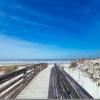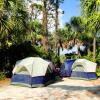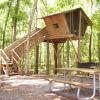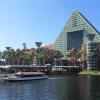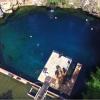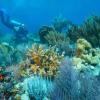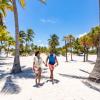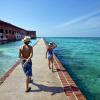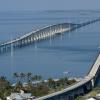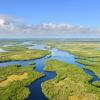By Chelle Koster Walton
Explore the history and landscape of these undisturbed areas along the Gulf Islands National Seashore in Florida.
I sometimes have to remind myself I'm on Planet Earth when I drive through the National Seashore, especially the part that engulfs the road between Pensacola Beach and Navarre Beach. If I let it, the undulating dunes and stark white sand will take me back to the snow drifts of Minnesota, or to footage of the moon landing. Then glimpses of the shimmering emerald waters bring me back to Florida, to the upper Gulf coast, where the sand doesn't get any whiter or softer, or the dunes any more spectacular.
Gulf Islands National Seashore of Pensacola protects 5,842 acres of public land and 18,953 acres of water along 52 miles of Gulf and bay shoreline around Pensacola. The seashore is not continuous, but spread out over one Florida island, parts of other islands and Mississippi. National parks and other protected public-use areas provide access to the intriguing terrain and opportunity for playing in the seductive sand.
The largest parcel lies within Fort Pickens at the west end of Pensacola Beach on Santa Rosa Island. During the Civil War, the Union and Confederacy divided Pensacola. While Rebel forces occupied Fort McRee on nearby Perdido Key and Fort Barrancas on the mainland, Federal troops moved into Fort Pickens, one of only three Union strongholds in Florida. In later years, the fort gained attention when the government sent Geronimo and his band there for incarceration. Tourists by the boatload would sail by in hopes of a glimpse of the mighty American Indian warrior.
The massive brick fort and its ruins spread over the park's 1,742 acres. The island slims down as you enter the park, to let you glimpse views of both the Gulf and the bay. At Langdon Beach, battery remnants begin to crop up among the dunes. Picnic shelters are found both on beach and bay. A Dune Nature Trail snakes through this sea- and wind-whipped environment that turns magnolias, pines and oaks into bonsai versions. Wild flowers and sea grasses add color to the searing whiteness and sightseeing for bicyclists following a 2.2-mile bike trail.
The actual fort structure occupies the very western tip of the island. Here, visitors can travel back in time through the archways and tunnels, to the escarpments, casements, bastions and cannon. Tours can be self-guided or guided. On certain nights, candlelight tours add an element of historical authenticity and eerie romance.
East of Fort Pickens, between Pensacola Beach and Navarre Beach, the Opal Beach Area Gulf Islands National Seashore of Florida is less facilitating, but perhaps even more alluring with its uninterrupted stretches of wind-sculpted dunes rippling as far as the eye can see. Salty wind off the Gulf sends the fine sand blowing across the road like sugar coating. Signs warn motorists not to leave the road. The unheeding sometimes get stuck in sand drifts. Nearly eight miles of road traverse this departure from civilization, with only an occasional parking lot and restroom facility to mark human presence and allow access to the Gulf.
On the mainland side of Santa Rosa Sound on the Gulf Breeze peninsula, Naval Live Oaks Reservation accounts for 1,337 acres of the national seashore. It has a small beach, but the emphasis here is on nature hiking and education. Five miles of trail penetrate live oak and gray squirrel habitat and pass the shell middens left by ancient American Indian cultures. The visitors' center holds exhibits on archaeology and the harvesting of live oak trees.
The patch of National Seashore occupied by Fort Barrancas lies also on the mainland at Naval Air Station Pensacola, overlooking the entrance to Pensacola Bay and Fort Pickens, erstwhile enemy camp. You can tour the fort on your own or with a guide.
To the east of Fort Barrancas, on Perdido Key, Gulf Islands protects 1,041 acres of stunning dunescape. The Johnson Beach Day Use Area supplies access to the seashore at Perdido's east end. It's a popular spot for beach-goers, but you can easily lose the crowds on the six miles of beach. Fort McRee once stood sentry at island's end, but remains have been cleared away or have long since slipped into the sea.

